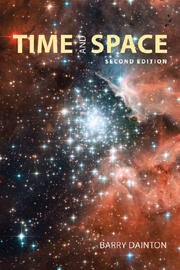Book contents
- Frontmatter
- Contents
- Preface to the second edition
- Preface to the first edition
- 1 Preliminaries
- 2 McTaggart on time's unreality
- 3 The Block universe
- 4 Asymmetries within time
- 5 Tensed time
- 6 Dynamic time
- 7 Time and consciousness
- 8 Time travel
- 9 Conceptions of void
- 10 Space: the classical debate
- 11 Absolute motion
- 12 Motion in spacetime
- 13 Curved space
- 14 Tangible space
- 15 Spatial anti-realism
- 16 Zeno and the continuum I
- 17 Zeno and the continuum II
- 18 Special relativity
- 19 Relativity and reality
- 20 General relativity
- 21 Spacetime metaphysics
- 22 Strings
- Notes
- Glossary
- Web resources
- Bibliography
- Index
19 - Relativity and reality
- Frontmatter
- Contents
- Preface to the second edition
- Preface to the first edition
- 1 Preliminaries
- 2 McTaggart on time's unreality
- 3 The Block universe
- 4 Asymmetries within time
- 5 Tensed time
- 6 Dynamic time
- 7 Time and consciousness
- 8 Time travel
- 9 Conceptions of void
- 10 Space: the classical debate
- 11 Absolute motion
- 12 Motion in spacetime
- 13 Curved space
- 14 Tangible space
- 15 Spatial anti-realism
- 16 Zeno and the continuum I
- 17 Zeno and the continuum II
- 18 Special relativity
- 19 Relativity and reality
- 20 General relativity
- 21 Spacetime metaphysics
- 22 Strings
- Notes
- Glossary
- Web resources
- Bibliography
- Index
Summary
Reality unconfined
We turn now from the physics of str to its metaphysical interpretation. I want to focus on some influential lines of argument that attempt to draw very significant conclusions about the nature of time from the distinctive spacetime geometry of str. These arguments takes as their target all those dynamic models of time according to which there is an ontological asymmetry between past, present and future. As we have seen, there are several such models. Presentists of all persuasions are agreed that the past and the future are unreal; the Growing Block theory of Broad and Tooley is more liberal, and withholds reality only from the ever-shrinking future. In both cases, the present has special ontological significance, constituting as it does the frontier between what is real and what is not. In outlining these theories I tacitly assumed that the present extends through out the universe and is absolute (i.e. non-perspectival, non-frame-relative). Let us call models of time that posit an absolute and universal present, and hence an absolute and universal tide of becoming (or annihilation) “classical dynamic models”, or cdms. Given what we have seen so far, it is obvious that there are certain tensions, to say the least, between cdms and str. One of the questions we will be addressing in this chapter is whether these tensions are fatal to cdms. We will also be exploring the options for non-classical dynamic models of time in the context of str.
- Type
- Chapter
- Information
- Time and Space , pp. 328 - 342Publisher: Acumen PublishingPrint publication year: 2010



